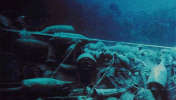-
- container colonna1
- Categorie
- #iorestoacasa
- Agenda
- Archeologia
- Architettura
- Arte antica
- Arte contemporanea
- Arte moderna
- Arti performative
- Attualità
- Bandi e concorsi
- Beni culturali
- Cinema
- Contest
- Danza
- Design
- Diritto
- Eventi
- Fiere e manifestazioni
- Film e serie tv
- Formazione
- Fotografia
- Libri ed editoria
- Mercato
- MIC Ministero della Cultura
- Moda
- Musei
- Musica
- Opening
- Personaggi
- Politica e opinioni
- Street Art
- Teatro
- Viaggi
- Categorie
- container colonna2
- container colonna1
Tesori sommersi. Da salvare
Diritto
di fabio marazzi
I fondali marini conservano un ricchissimo patrimonio di reperti di grande interesse storico ed artistico. Difficile ne risulta però molto spesso la tutela e la conservazione. Il professor Fabio Marazzi ci racconta le principali problematiche del settore…
I fondali marini conservano un ricchissimo patrimonio di reperti di grande interesse storico ed artistico. Difficile ne risulta però molto spesso la tutela e la conservazione. Il professor Fabio Marazzi ci racconta le principali problematiche del settore…
La legislazione italiana è carente e lacunosa sulle disposizioni da adottare nel recupero di beni culturali sommersi, quali possono essere i resti archeologici ed i relitti. Il Testo Unico (D. Lgs. 29 ottobre 1999, n. 490) accenna, nell’elenco iniziale, a “beni mobili o immobili che presentano interesse archeologico” ed ai “mezzi di trasporto aventi più di settantacinque anni”, ma non entra nel merito dell’ubicazione e dunque non prende in considerazione tutta una serie di problematiche legate appunto alla particolare situazione del bene sommerso, alla sua protezione ed al suo recupero.
A livello internazionale l’attenzione ai beni culturali sommersi ed alla loro conservazione è più estesa, tanto che molti Stati si sono dotati di appositi regolamenti e l’ Unesco, il 2 novembre 2001, ha adottato la Convenzione sulla Protezione del Patrimonio Culturale Sommerso (Convention on the Protection of the Underwater Cultural Heritage).
La Convenzione nasce dalla considerazione che i beni sommersi siano parte integrante del patrimonio culturale dell’umanità e rappresentino un importante elemento di storia per popoli e nazioni. In base a ciò, la loro conservazione è responsabilità precipua di ogni Stato, che deve dunque tutelare il valore educativo del bene, impedirne qualsiasi sfruttamento illecito o dispersione e fissare metodi scientifici di intervento per il recupero.
Importante è stata la previsione normativa delle aree sottoposte al controllo della Convenzione e la precisazione degli obblighi e dei diritti di ciascun Stato su ognuna di queste zone.
Sei sono i settori presi in considerazione: le acque interne, le acque territoriali (a 12 miglia nautiche dalla riva, in cui lo Stato è sovrano e le navi hanno diritto di passaggio), la zona contigua (per altre 24 miglia nautiche, dove lo Stato esercita controllo per prevenire infrazioni alle proprie leggi commerciali, fiscali e di immigrazione), la piattaforma continentale(dove lo Stato costiero esercita diritti sovrani con lo scopo di esplorare e sfruttare le sue risorse minerali e naturali), la zona economica esclusiva (EEZ, a 200 miglia nautiche dalla riva, in cui lo Stato è sovrano sulla massa d’acqua al di sopra della piattaforma continentale) e l’Area (letto marino e sottosuolo oltre i limiti di giurisdizione nazionale; l’Area e le sue risorse sono patrimonio comune dell’umanità). Tuttavia il sistema delineato complessivamente dalla Convenzione non è privo di mancanze e lacune. Si stabilisce, ad esempio, che gli Stati contraenti abbiano diritto sovrano ed esclusivo di regolamentare ed autorizzare qualsiasi attività diretta a beni culturali sommersi nelle acque interne, negli arcipelaghi e nelle acque territoriali (art. 7). Nel caso di recupero di un vascello appartenente ad un altro Stato firmatario, è prevista l’informazione e la collaborazione con quest’ultimo. In questo caso però, poichè il vascello e tutto quanto contiene sarebbe sotto la sovranità dello Stato di appartenenza, la Convenzione si mostra insoddisfacente e si porrà la necessità che i due Stati giungano ad accordi separati per continuare le ricerche.
Tutti gli Stati membri hanno la responsabilità di proteggere i beni sommersi nelle zone economiche esclusive e sulla piattaforma continentale: perciò, di ogni scoperta va informato sia lo Stato di appartenenza del bene rinvenuto, che lo Stato cui appartiene la zona di ritrovamento (art.9) . Ogni Stato ha la possibilità di impedire i lavori per prevenire interferenze sulla sua sovranità e deve consultarsi con l’organo di coordinamento degli Stati per la conservazione e la protezione (art. 10).
Nel caso di ritrovamento nella zona definita Area, fuori dai limiti della giurisdizione nazionale, gli Stati devono proteggere il bene ed informare delle scoperte l’International Seabed Authority. Purtroppo, le procedure sono molto burocratiche, e il tutto è lasciato alla buona volontà degli Stati ed alla loro effettiva volontà di cooperare.
Va comunque sottolineato che la Convenzione Unesco, malgrado le lacune e i problemi applicativi ed interpretativi, è a tutt’oggi uno dei più completi apparati di leggi in questo campo ed è quindi uno strumento normativo fondamentale per evitare la dispersione di importanti patrimoni culturali. E’ rimasto negli annali il caso della nave olandese Geldermahlsen, naufragata nel 1752 nel Mar della Cina, il cui intero carico è stato venduto da Christie’s per circa 10 milioni di dollari nel 1985. Sebbene le autorità olandesi avessero tentato di boicottarne la vendita, non essendoci ancora una legislazione precisa in materia, non poterono nulla, e molti reperti finirono al British Museum e dispersi in asta. Più di recente si è verificato il caso dell’ Albion e dell’ Industan, navi mercantili del XIX secolo ritrovate nell’estuario del Tamigi; il carico di entrambe fu conservato senza alcun criterio in magazzini industriali nell’attesa che le leggi si accordassero su chi fosse il legittimo proprietario. Nel 1994, quanto si era potuto salvare, fu svenduto sul mercato antiquario.
fabio marazzi
[exibart]












.jpg)





















Gentile Sig. Marazzi,
è facile per l’Unesco fare trattati di conservazione archeologica, ma nel caso del recupero di oggetti dal fondo marino un simile trattato è pura retorica.
In primo luogo, la maggioranza dei relitti al mondo ha una relativissima importanza storica o archeologica. Chi fa del recupero, non va a staccare cannoni con la dinamite, ma in genere “scopre” i relitti dalla sabbia e detriti, con un normale apparato di suzione (per i suoi costi, questo lavoro difficilmente verrà mai effettuato da qualche governo a fini storici e turistici). I governi dal canto loro non hanno nessuna intenzione di proteggere i relitti, ma di legiferargli attorno per reclamare parte del ‘bottino’ in caso qualche privato lo trovi.
Numerosi relitti sono localizzati in aree impossibili al turismo subacqueo. “Proteggere” tali relitti e il loro contenuto assicura solo spese esorbitanti (in caso di effettivo controllo e senza pensare alle spese di recupero), e la distruzione dello scafo e il suo contenuto prima ancora che chiunque abbia potuto fruirne.
Peraltro chi fa recupero, preferirebbe di gran lunga trattare con istituzioni per un compenso non esoso, ma l’eccesso di burocrazia e grattacapi che il brouhaha dei ‘conservatori’ crea, scoraggerebbe chiunque volesse liberarsi del ritrovato per le vie ufficiali.
Inoltre c’è chi vuole vivere in mare, ne vuole fare un mestiere e una vita. Per vivere, può portare in giro turisti (a vedere balene, spiaggie e tramonti), può pescare, e può rimettere in circolazione cose che altrimenti andrebbero perse.
Le vecchie regole di mare hanno degli ottimi motivi per esistere, così come sono.
Ho trovato questo articolo molto competente sulla situazione reale, dal giornale Guardian.
http://www.guardian.co.uk/uk_news/story/0,,462265,00.html
Oliver Burkeman
Saturday March 24, 2001
The Guardian
Wild weather was brewing on the Barents sea, off the coast of Russia, the
day Keith Jessop and his colleagues finally found the bullion on board HMS
Edinburgh. Years of research had prepared the Yorkshire-born diver turned
treasure seeker, now aged 57, for what he might find – but he only believed
it when he finally held the first of 431 gold bars.
“I did it for the money, of course,” he says. “We’re talking about vast
amounts of money here.” It was £45m of bullion, lost when the naval cruiser
was sunk in battle in 1942 while carrying payment for military equipment
from Murmansk in Russia to Scotland.
Jessop – 16 years after his find and largely retired – is only one of the
best-known of a thriving international band of commercial bounty-hunters who
have made billions from locating and recovering bullion and artifacts from
historic wrecks, thanks to the unwritten law of “finders keepers” on the
high seas. Viewed as romantic buccaneers or unprincipled plunderers, no
ships are immune from their activities: salvage rights to the most famous
wreck of all, the Titanic, belong to an Atlanta-based company, RMS Titanic
Inc.
But next Monday in Paris, representatives of around 100 governments will
gather at a Unesco summit expected to result in an international convention
that would ban commercial divers from salvaging any wreck older than 100
years – ruling out many historic wrecks, including hundreds of Spanish
fleets off the American coast, and setting the clock ticking for a host of
wrecks sunk in the early 20th century.
Although the US and British governments have expressed reservations about
aspects of the proposals, the summit is expected to conclude that, in the
UN’s words, “the commercial exploitation of underwater cultural heritage for
trade or speculation, or its irretrievable dispersal, is fundamentally
incompatible with the protection and proper management of the cultural
heritage”.
A spokesman for the culture department said: “The UK position is that [the
convention] should only extend protection to shipwrecks of scientific, his
torical or archaeological significance. We do not believe that blanket
protection applied to all wrecks over a certain age is either workable or
desirable.” But for Keith Jessop and his followers, it seems, the game may
be up.
“There is simply no satisfactory international instrument for the protection
of underwater heritage,” says Lyndell Prott, a marine archaeologist at
Unesco who is coordinating the negotiations. “Finally, we are hoping to set
a standard that will be the basis of international legislation.”
The market in privately salvaged treasure is a vast one. Thanks to advances
in sonar sea-bed scanning technologies, treasure-seekers previously confined
to shallower waters, have the deepest oceans at their disposal. Christies,
the leading auction house in the field, in one recent and not untypical sale
raised £2.2m for 24,000 pieces of porcelain recovered from a
British-registered merchant ship which vanished off Malaysia in 1917.
A vigorous market in plundered goods has grown up on the internet, too: at
the website of the US-based Historical Research and Development, for
example, one can purchase everything from shards of crockery ($14.95) to
gold buttons from the uniforms of the perished crew of the Nuestra Senora de
la Regla, part of a Spanish fleet sunk off the US in 1715, for $6,900 a
pair. The eventual haul from the fleet is expected to raise $200m.
The law of the sea, meanwhile – a hotchpotch of national legislation and
vague references in two international conventions – provides governments
with rights only to wrecks in their coastal waters.
Even in coastal waters, the current situation produces some bizarre
anomalies. Last month, in a historic ruling, the US supreme court ruled that
shipwrecks of two 18th-century Spanish craft, the La Galga and the Juno,
belonged not to the American millionaire Ben Benson, who had claimed them
with the agreement of the state of Virginia, but to the King of Spain.
“Sovereign ships are honoured graves,” the US department of justice
successfully argued of the ships, which were sunk in battle, and should not
be “subject to exploration or exploitation.” The ruling is believed to lend
weight to Spanish claims for more than 250 other ships.
Marine archaeologists are also worried by a growing trend for struggling
governments to sell exploration and salvage rights to private foreign
speculators. Late last year Cuba sold a license to dive for gold in an
estimated 16,000 Spanish wrecks in its coastal waters to an American
internet millionaire, Rory Boyes-Varly, for an undisclosed sum. Boyes-Varly
has enlisted a Scottish company run by a 24-year-old Edinburgh University
graduate, Gordon Stove, to co-ordinate the search.
“These practices do not even make sound economic sense for the countries
involved,” says Lyndell Prott at Unesco. “An excavation, where the finds go
to the museums of the host state – such as the wreck of the Wasa in Sweden –
often provides an income they wouldn’t get if they sold the material for
commercial benefits.”
The commercial salvors insist that without private investment the wrecks
would never be found in the first place. “You don’t find these things by
bloody mistake,” says Keith Jessop. “The governments only want to get
involved when the things get found, but who gives them the right to call it
history? If a treasure ship’s been lost for 500 years and you’ve never found
it by now, I’d call it abandoned.”
Tom Gidus, director of the Florida-based Wreckovery salvage firm, says
commercial operators do a better job of protecting heritage in any case.
Hunters’ hauls
Titanic Sunk by an iceberg on its maiden voyage to the US from Belfast in
1912, salvage rights to the famous liner, and an estimated $300m in jewels
and artifacts, much still to be recovered, were not claimed by discoverer
Bob Ballard, and are now owned by a US firm, RMS Titanic Inc. Last year a US
court forbade it to sell any relics.
Tek Sing A160ft Chinese ship that hit a reef in 1822 off Indonesia. Last
year it was located by UK treasure hunter Michael Hatcher, who found 350,000
pieces of exquisite porcelain and skeletons of some of 2,000 passengers.
Lusitania The liner was torpedoed in 1915 off Cork, en route from New York
to Liverpool. It remains caught in a legal dispute between US businessmen
who own salvage rights and the Irish government.
Last year a divers’ report warned the wreck was rotting away at an alarming
rate.
HMS Edinburgh The cruiser went down in the Barents sea off Murmansk in 1942.
Inside was 4.5 tons of gold – part payment for the Soviet Union’s war
supplies. In 1981, ingots were brought up with equipment borrowed from oil
companies.
Still searching
The Empress of Britain Sunk off Ireland in 1940 and the site of the wreck
never discovered. Treasure hunters believe that a cargo of gold bullion
awaits them.
Laconia A Cunard liner that sank off Fastnet in 1917 while carrying an
estimated £3.5m in silver.
Blessing of Burntisland Charles I’s ship sank in the Firth of Forth
carrying, among other things, a priceless 250-piece silver tea service.
Despite a number of private searches, the wreck has yet to be found.
Saluti
FS